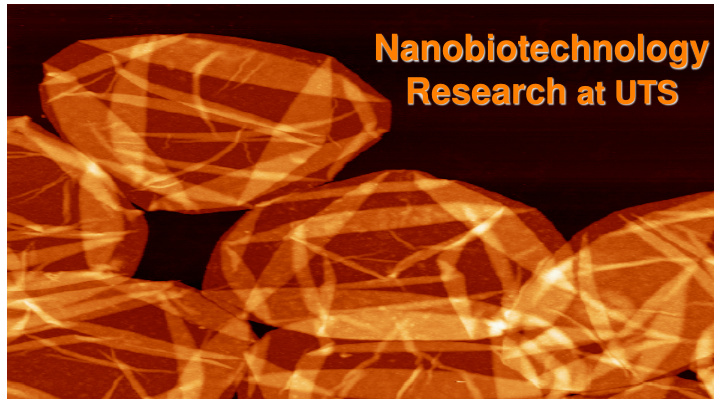



Nanobiotechnology Research at UTS
STELLA VALENZUELA HTTPS://WWW.UTS.EDU.AU/STAFF/STELLA.VALENZUELA • Molecular and Cell Biologist working in the area of Bionanotechnology • Joined UTS 2001, previously worked at UNSW Faculty of Medicine, Centre for Immunology, St Vincent’s Hospital, Cellabs P/L and Australian Monoclonal Development P/L • Current industry partner - Surgical Diagnostics P/L together since 2004 held 3 ARC Linkage projects ($0.7M ARC funding) currently hold a joint ARC DP grant with SDX and UNSW and part of new ARC Industry Transformation Research Hub ($3.7M ARC funding) • New industry partner – BOD Australia P/L • Other collaborators BRAGG Institute ANSTO, UNSW, Macquarie Uni science.uts.edu.au
The scale of things: Nanoscale objects are any structures that are <100nm in size. www.nano.gov science.uts.edu.au
Nanobiotechnology All biological systems operate via a process of molecular recognition ; for example: hormones, cytokines, antibodies, neurotransmitters, ion channel gating, gene expression. Bionanotechnology Research at UTS has at its core the study of the molecular basis of biological recognition mechanisms: • functional / kinetics studies • structural studies Applications: drug delivery • therapeutic applications • pesticides • implantable devices •
science.uts.edu.au
Nanobiotechnology Nanomaterials Nanodevices Nanocharacterisation science.uts.edu.au
“ SMART ” LIPOSOMAL SYSTEMS Lipid coated polyelectrolyte capsules Lipid coated polyelectrolyte capsules Non-lipid coated polyelectrolyte capsules science.uts.edu.au
TARGETED CELL KILLING USING GOLD CONJUGATED ANTIBODIES AND EXPOSURE TO PHOTOTHERMAL ENERGY RAW cells+gold+laser RAW cells+laser Dakrong Pissuwan, Stella M. Valenzuela and Michael B. Cortie. (2006) Therapeutic possibilities of plasmonically heated gold nanoparticles. Trends in Biotechnology. 24(2): 62-67. science.uts.edu.au
TARGETED CELL KILLING USING GOLD CONJUGATED ANTIBODIES AND EXPOSURE TO PHOTOTHERMAL ENERGY TEM image of functionalised gold nanoparticles attached to Toxoplasma gondii parasites science.uts.edu.au
science.uts.edu.au
LIPID-MEMBRANE TECHNOLOGIES… (A) AFM error mode image of S100A8/A9 protein complex associated with lipid (the complex with the lipid had been preincubated at 37 o C). The protein complex ranged from 35 to 45 nm in diameter; (B) Cross section of S100A8/A9 in lipid revealed a lipid height of 1.3 nm and a protein height of 5.3 nm; (C) AFM height mode image of S100A8/A9 protein complex preferentially attached to the edges of the lipid “ patches ” . Stella M. Valenzuela, Mark Berkahn, Donald K. Martin, Thuan Huynh, Zheng Yang, Carolyn L. Geczy. (2006) Elucidating the Structure and Function of S100 Proteins in Membranes. Proc. of SPIE: BioMEMS and Nanotechnology II. Volume 6036: 603619-1. 11 science.uts.edu.au
S100A9 Protein Imaged in Buffer Using Tapping Mode AFM science.uts.edu.au
CLICs are highly conserved across vertebrates with related CLIC-like proteins in invertebrates Vertebrate CLICs CLIC1-CLIC6 Invertebrate CLICs EXC-4, EXL-1 Dm CLIC Littler et al FEBS 584:2093 (2010) science.uts.edu.au
NOT A TYPICAL ION CHANNEL PROTEINS - SPONTANEOUS MEMBRANE INSERTION OF SOLUBLE CLIC1 Extracellular fluid Plasma Membrane Intracellular fluid Transmembrane Channel form form Factors that regulate the membrane insertion of CLIC1: Redox environment Low pH Membrane lipid composition CLIC1 proteins Harrop S et al, J Biol Chem , 276(48) :44993-45000 . science.uts.edu.au
PROTEIN CONDUCTANCE MEASUREMENTS USING TETHERED MEMBRANES AND IMPEDANCE SPECTROSCOPY Protein science.uts.edu.au
science.uts.edu.au
Conductance of CLIC1 in tBLMs containing varying ratios of cholesterol science.uts.edu.au
Langmuir monolayer films science.uts.edu.au
science.uts.edu.au
Effect of cholesterol on CLIC1 protein interactions with mixed lipid monolayers science.uts.edu.au
Spontaneous Membrane Inserting Proteins Bacterial toxins like listeriolysin, perfringolysin, streptolysin Pneumolysin science.uts.edu.au
ACKNOWLEDGEMENTS Dr Heba Al Khamici Prof Mike Cortie Ms K Rufaka Hossain Ms Hala Ali Dr Lele Jiang A/Prof Mary Davey Dr Josh Chou Prof Don Martin Mr Mark Berkhan Prof Bruce Cornell Dr Stephen Holt BRAGG Institute ANSTO Prof Paul Curmi UNSW Dr Victoria Timchenko UNSW Dr Louise Brown Macquarie University Prof Sam Breit St Vincent’s Hospital Sydney science.uts.edu.au
Recommend
More recommend